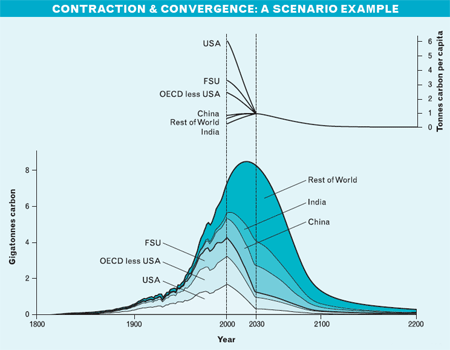Tiempo Climate Cyberlibrary
Contraction and Convergence
- Tiempo archive
- Complete issues
- Selected articles
- Cartoons
- Climate treaty
- Latest news
- Secretariat
- National reports
- IPCC
About the Cyberlibrary
The Tiempo Climate Cyberlibrary was developed by Mick Kelly and Sarah Granich on behalf of the Stockholm Environment Institute and the International Institute for Environment and Development, with sponsorship from the Swedish International Development Cooperation Agency.
While every effort is made to ensure that information on this site, and on other sites that are referenced here, is accurate, no liability for loss or damage resulting from use of this information can be accepted.
  |
Aubrey Meyer and Raphaël Hanmbock describe Contraction and Convergence, a flexible and equitable response to climate change after the Kyoto Protocol. |
|
Aubrey Meyer, a musician by training, co-founded the Global Commons Institute in London in 1990. Since then, he has contributed to the Intergovernmental Panel on Climate Change and campaigned to win acceptance of Contraction and Convergence. Raphaël Hanmbock is Executive Director of ACAN (Association des Clubs des Amis de la Nature) and Coordinator of the Climate Action Network in the Cameroon. |
|
In May 2004, the New York Times wrote: "Without international action - a new Manhattan Project to develop low-impact energy technologies and a revolutionary commitment to global equity - climate change promises social and economic collapse."
Some senior advisors to the United Kingdom's Prime Minister, Tony Blair, know this very well. John Houghton, ex-head of the United Kingdom (UK) Met. Office, has described climate change as "a weapon of mass destruction" that is "already upon us." David King, the British government's chief scientific adviser, has called climate change a far greater threat than international terrorism.
Mr Blair himself declared on 27th April 2004, when launching the Climate Group, that "the issue of climate change is now very, very critical indeed." He is right. Humanity is increasing rather than reducing its emissions of the greenhouse gases that are changing the world's climate.
To avoid disaster, a comprehensive response is urgently required. The global community must negotiate a plan to bring emissions down rapidly using the flexible, science-based Contraction and Convergence framework. It is difficult to think of any other effective approach in the battle to avoid dangerous rates of global climatic change.
The Global Commons Institute (GCI) first proposed the principle of Contraction and Convergence (henceforward C&C) to the United Nations in detail in 1996. C&C was adopted by the Africa Group the following year. The basic principle behind the approach is that international negotiations must aim at securing safe and stable atmospheric greenhouse gas concentrations using the principles of precaution and equity agreed under the United Nations Framework Convention of Climate Change (UNFCCC).
In essence, the C&C framework provides a means of calculating any number of possible future global greenhouse gas emission scenarios within the overall conditions that:
- annual emissions contract by some future date to a (much) lower level than today; and,
- there is convergence from the current huge range of per capita greenhouse gas emissions to a situation where everyone on the planet has equal emission rights.
Emissions rates can be calculated for every country and future year. The rate of global emissions for full contraction, the year when this is achieved, and the year when per capita emission rights converge, can all be set independently. The C&C model thus provides a very flexible tool for climate negotiations.
Guided by the Intergovernmental Panel on Climate Change (IPCC) Working Group One, the C&C model can embody crucial elements of climate change science as well as generate critical factors for international climate negotiations. It can calculate:
- any full-term contraction budget for a specified tonnage of annual global emissions consistent with stabilising atmospheric concentrations of greenhouse gases at a pre-agreed concentration maximum; and,
- how this budget might be shared through international and constitutional agreements as 'tradable emissions entitlements'. This results from a (negotiable rate of) convergence to equal emissions shares per person globally by an agreed date within the full-term contraction/concentration budget.
C&C, therefore, has an advantage over alternative proposals, like the Kyoto Protocol, that somewhat arbitrarily invent targets as they proceed. The Global Commons Institute is currently of the view that greenhouse gas concentrations higher than a level equivalent to 450ppmv carbon dioxide are not safe. It thinks that contraction budgets should be drawn up now, and that convergence should be completed around a third of the way through the proposed contraction budget.
This proposed scenario is fair because, historically, most greenhouse gas emissions originated from developed countries. It would mean, for example, that in the year 2030 (or around a third of the way into a 100-year budget), convergence of per capita emission entitlements should have occurred. National emissions entitlements can, perhaps, be calculated using a population base year as part of negotiated C&C agreements. Any agreement reached should be rights-based, where, subject to appropriate rules, emissions entitlements are considered tradable.
The historic debt of climate change limits the progress of development in the South. It is, therefore, important to recognize that the sooner the date for which full convergence to equality of future entitlements is agreed, the sooner and better this historic debt can be settled. If the date is set sooner rather than later, developing countries will also receive a greater share of tradable emissions entitlements. This is made possible under C&C, because convergence is simply a share issue of emissions-entitlements rather than emissions per se. Subject to agreed C&C limits, emission trading can ease and hasten the transition.
Some people say, untruthfully, that C&C imposes reduction targets on developing countries. Particularly in view of the scenario described above, the opposite is in fact true. Much depends on the rates of emissions contraction and convergence that are negotiated. Moreover, accelerating convergence relative to a specified rate of contraction is safer for all parties than our present behaviour of delaying contraction as a consequence of denying convergence. The current scenario is typified by delay, which means that the cost of climate damages is rising potentially beyond our ability to pay or to adapt.
The Global Commons Institute realises that as scientific understanding of the relationship between an emissions-free economy and concentrations develops, agreed rates of C&C will need to be subject to periodic revisions. Concentrations and temperature will, however, be rising throughout the period of contraction. So in view of the increasingly dangerous conditions under which this will be happening, the prime virtue of having a formal and revisable C&C agreement is that revisions can be negotiated within the same overall architecture.
|
|
|
One of many possible developments of global greenhouse gas emissions and associated per capita emissions calculated by the C&C model. In this case, convergence to equal per capita emission shares occurs in 2030. FSU refers to countries that constituted the 'former Soviet Union'; OECD to the rich, industrialised countries within the Organisation for Economic Cooperation and Development. © GCI |
The Global Commons Institute proposes that UNFCCC negotiations for this primary C&C agreement should occur principally between the North and the South as blocks. Further negotiations over sharing entitlements could continue between and within regions (such as the European Union, the Africa Union and the United States), while the collective course to stabilisation is maintained and revised as necessary. The Global Commons Institute also suggests that the inter-regional, inter-national and intra-national tradability of these entitlements should be transacted in a resource-standard global currency, such as the Emissions-Backed Currency Unit argued for by the Foundation for the Economics of Sustainability.
Amongst the oldest and strongest supporters of the C&C approach has been the Africa Group of nations. In 1997, when it championed C&C at the Third Conference of Parties to the UNFCCC, the group consisted of sixteen Anglophone African countries that were well aware of how devastating climate change already was for Africa. They knew that C&C protected the global climate and their share of the valuable tradable equity being created. Then, supported by many in and around the negotiations, their initiative was kept vigorously alive right through the Kyoto negotiations. At the climax of these, when the subject of emissions trading was being negotiated, their demand for C&C was tabled again, with support from the key Southern players.
The United States delegation - under pressure to win acceptance of emissions trading - responded by saying that C&C could be the basis of the next agreement. In 2000, when the IPCC concluded that "Contraction and Convergence takes the rights based approach to its logical conclusion," the United States withdrew from implementation of the Kyoto Protocol.
So C&C is a stiff challenge to those who seek to manage the global climate account under the Kyoto Protocol. So far, the price at which permits are to be traded under the Protocol does not begin to reflect the equivalent unit of damage from the emissions that change the climate. And while a few people gain rights, most actually lose them. Moreover, lives, real estate and other assets are being lost as well.
To stop the climate changing, we have to solve the problem collectively and faster than we create it. In this respect, the Kyoto Protocol is worse than inadequate. It disguises the severity of the problem. It has no agreed maximum of global carbon dioxide concentrations or emissions and so lacks the focus and structure required for any sustainable solution. Furthermore, the lucrative tradable emissions entitlements it creates are globally quite arbitrary. Creating equity-share - only for some - at the expense of climate stability and the poor and the vulnerable, can only promote conflict and disaster. No one can unilaterally create ownership of the global commons by assertion and succeed. Moreover, to trade what you do not own, prospering from the pain caused to others, is legally dubious.
C&C is constitutional and based on science and logic. It is a full-term, universal, rights-based framework designed to shrink emissions by focusing on the already dangerous rising greenhouse gas concentrations. As required by the UNFCCC, it is a rational and transparent global structure of precaution and equity that forces and finances the transition to sustainability for all parties from available renewable energy technologies and techniques. C&C gives us a way to enact our collective contract between present and future generations in a new economic paradigm for making sustainable development possible for all in the 21st century.
Those who rely on the Kyoto Protocol do not merely fail these tests; they refuse to take them. The original Kyoto Protocol was massaged to try to keep the United States on board. So now that the United States has withdrawn from the Protocol, why does anyone maintain allegiance to the drastically weakened targets insisted on by the United States before it withdrew from it? And more importantly, why do parties continue with this failed model of negotiation? The truth is that, with their focus on the economy, the Kyoto Protocol's defenders do not count the things that matter; they count short-term profit and status before precaution and equity.
The accelerating rise of greenhouse gas concentrations in the atmosphere demonstrates how inadequate the Kyoto Protocol is in the short-term. Just one year of serious sink-failure numerically swallows the Protocol's theoretical 'gains'. Even in a good year, the Protocol's procedures do not even slow the upward acceleration of emissions, let alone decelerate the rise of concentrations. And in terms of rising temperatures, expectations are low, as changes have barely begun.
The UNFCCC set out to defend the planet against the devastating uneconomic growth of the rich. The Kyoto Protocol reversed this trend in favour of those whose interests are vested in this growth at the expense of the poor and the planet. Former consultants to the Small Island States now broker emission permits under the Protocol, while the homes of their former island clients are made uninhabitable by the rising seas.
Former climate action radicals, who denounced the original Kyoto Protocol at its birth in 1997 as a tragedy and farce, now defend its horse-trading and weakened revisions as a basis on which to continue to the Kyoto Protocol's second commitment period. The weakening of the Protocol's 'targets' is problematic in itself, but the lack of architecture is a greater defect. It is the absence of this architecture that disqualifies the Kyoto Protocol, and its variants, as a basis for the future.
The Kyoto Protocol's government and non-government stakeholders have colluded in inadequacy and evasion. They have ignored the science and the obvious concept of equal rights to the global commons. Many actors promote the next commitment period of the Kyoto process and describe the first commitment period, which ends in 2008-2012, as a great achievement. This is rhetoric. The Kyoto Protocol is at best symbolic of our intent. Numerically, it is a measure of growing confusion and failure, not success.
Tough but true, 'Kyoto-for-some' will either be superseded by 'Contraction and Convergence-for-all' or climate change will supersede us all. Since 1990, we have all faced a simple but urgent survival challenge. Can we cooperate and commit globally to solving the problem of human-induced climate change? In 1992, those who ratified the climate treaty committed themselves to answering "yes". By adopting it they said they could, and, on the basis of precaution and equity, they would meet this challenge. Ratification committed signatories to solving the problem faster than they created it.
Both the science and the logic decree that the UNFCCC stands for the 'United Nations Framework Convention for Contraction and Convergence'. We have to have a greenhouse gas concentration target with a globally equitable framework and institutions to match, if we are to survive.
Many eminent institutions including the UK's Royal Commission on Environmental Pollution, the German Advisory Council on Global Change, the international insurance industry, the nuclear industry and the World Bank, now use the C&C methodology to make this point.
Advised by scientists who support C&C, the Prime Minister Tony Blair is also correct when he said in his April 2004 Climate Group speech that, even if the Kyoto Protocol is fully implemented, "it falls significantly short of what we will need over the next half century if we are to tackle this problem seriously and properly." In the same speech, Blair also correctly affirmed that the cost of not acting is "so overwhelmingly greater than any short-term cost of action that we have to act and we have to act now."
With senior Africans, Mr Blair created the Africa Commission, to which Africa's climate, debt and development submissions will be made. He also pledged the G-8 agenda in 2005, above all things, to climate change and to Africa. He has called Africa's plight a scar on our conscience. We know that. Now he must ensure it doesn't get worse and he must help to heal it by supporting Africa's proposal.
Futher information
Aubrey Meyer, Global Commons Institute, 37 Ravenswood Road,
London E17 9LY, United Kingdom. Fax: +44-208-5204742.
Email: aubrey@gci.org.uk. Web:
www.gci.org.uk.
Raphaël Hanmbock, P O Box 8910, Deido Douala,
Cameroon. Fax: +237-3427703. Email:
climateafrica2005@yahoo.co.uk.
On the Web
Visit the Global Commons
Institute site for various resources, including a
downloadable C&C model, a slideshow, graphics and details
of current progress.
Bright Ideas

General Electric plans to cut solar installation costs by half

Project 90 by 2030 supports South African school children and managers reduce their carbon footprint through its Club programme

Bath & North East Somerset Council in the United Kingdom has installed smart LED carriageway lighting that automatically adjusts to light and traffic levels

The United States National Oceanic and Atmospheric Administration and the American Public Gardens Association are mounting an educational exhibit at Longwood Gardens showing the link between temperature and planting zones

The energy-efficient Crowne Plaza Copenhagen Towers hotel is powered by renewable and sustainable sources, including integrated solar photovoltaics and guest-powered bicycles
El Hierro, one of the Canary Islands, plans to generate 80 per cent of its energy from renewable sources

The green roof on the Remarkables Primary School in New Zealand reduces stormwater runoff, provides insulation and doubles as an outdoor classroom

The Weather Info for All project aims to roll out up to five thousand automatic weather observation stations throughout Africa

SolSource turns its own waste heat into electricity or stores it in thermal fabrics, harnessing the sun's energy for cooking and electricity for low-income families

The Wave House uses vegetation for its architectural and environmental qualities, and especially in terms of thermal insulation

The Mbale compost-processing plant in Uganda produces cheaper fertilizer and reduces greenhouse gas emissions

At Casa Grande, Frito-Lay has reduced energy consumption by nearly a fifth since 2006 by, amongst other things, installing a heat recovery system to preheat cooking oil
Updated: May 15th 2015
